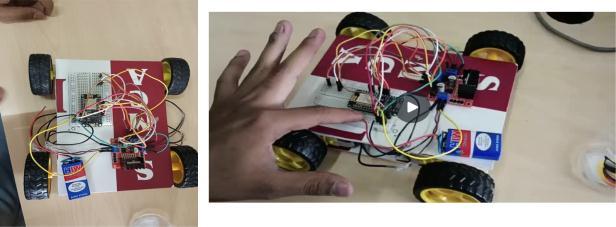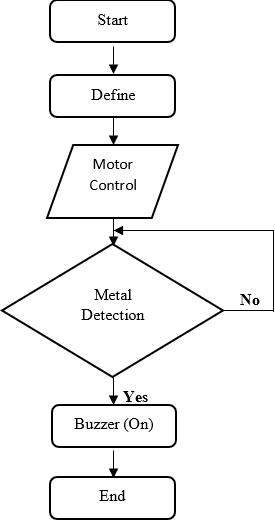Metal Detecting Bot using NodeMCU 8266
Dr. Shilpa Lambor, Atharva Kulkarni, Shrinidhee Kulkarni, Ajay Kulsange, Shubham Mane, Deepak Munde
Vishwakarma Institute of Technology, Bibewadi ***
Abstract The design, implementation, and assessment of a metal detecting bot using a NodeMCU, L298 motor driver, and A88 metal detector for more effective and efficient treasure hunting are presented in this research article. These components' characteristics are combined by the integrated system to produce a dependable and affordable metal detecting solution. The control unit, which enables real-time data collecting, processing, and decisionmaking, is the NodeMCU microcontroller board. The L298 motor driver optimizes search coverage by ensuring precise navigation and maneuverability of the bot. The electromagnetic signals produced by buried metallic objects are found and analyzed with the A88 metal detector. Extensive testing and comparison analysis support the heightened sensitivity, accuracy, and efficiency of the bot's treasure finding abilities. The outcomes show how well the bot works at finding and detecting different metallic objects, providing a useful and economical solution for applications involving treasure hunting. By combining the NodeMCU, L298 motor driver, and A88 metal detector, this research advances metal detecting technology and creates new opportunities for wider use in the fields of treasure hunting and archaeological study.
Index Terms adaptive cruise control, cruise control, lidar, radar, automotive technology

I. INTRODUCTION
Inmany fields, including archaeology, treasurehunting, and security applications, metal detecting is a commonly utilised method. Traditional metal detectors are reliable, but they can have drawbacks including expensive costs, restricted portability, and a lack ofcutting-edge features. Researchers and amateurs have been investigating the integration of contemporary technology to create more effective, pocket-friendly, and portable metal detecting systems in an effort to solve these difficulties. This research study focuses on the design, development, and assessment of a metal detecting bot that improves treasurefindingskillsbyusingaNodeMCU,anL298motor
driver, and an A88 metal detector. By combining these elements, a more dependable, affordable metal-detecting solution with higher performance is intended to be produced. The NodeMCU microcontroller board, which offers connection, processing power, and sensor integration capabilities, acts as the metal detecting bot's brain. Real-time data collection and remote control are made possible by its capacity to connect to Wi-Fi networks. The bot can move precisely and navigate differentterrains thankstotheL298motordriver,which makes it easier for it to do so. The very sensitive and adaptable A88 metal detector locates and identifies buried metallic objects by detecting and analysing electromagnetic signals that they emit. This research paper aims to evaluate the performance of the metal detecting bot through extensive experimentation and comparison with existing metal detection systems. The evaluation will focus on parameters such as sensitivity, accuracy, efficiency, and cost-effectiveness. The results obtainedwillvalidatetheproposedsystem'scapabilityto detectandlocatevarioustypesofburiedmetallic objects accurately.
II. Motive
The motivation behind this project stems from the limitations and challenges associated with traditional metal detection systems. While metal detecting has proven to be a valuable tool in various domains, such as archaeology and treasure hunting, there is a need for more efficient, cost-effective, and portable solutions to overcomethedrawbacksofexistingsystems.
One of the primary motivations is to address the high cost associated with traditional metal detectors. Many enthusiasts and researchers face financial constraints whenacquiringthesedevices, limitingtheiraccessibility. By utilizing affordable components such as NodeMCU, L298 motor driver, and A88 metaldetector, this project aims to provide a low-cost alternative that can be easily adoptedby a broader user base. The motivation also lies in the potential applications of the proposed system. Beyond treasure hunting and archaeology, this project could have implications for security and landmine
detection, where cost-effective and portable metal detecting solutions are highly desirable. Ultimately, the motivation behind this project is to contribute to the advancement of metal detecting technologies by addressing the limitations of existing systems. By integrating NodeMCU, L298 motor driver, and A88 metal detector, the project seeks to offer an affordable,portable, and efficient metal detecting bot that can be utilized by researchers, enthusiasts, and professionals in various domains,openingup newpossibilitiesinthefieldofmetal detectionandexploration.
III. Literature Review

This literature review aims to provide an overview of existing research and technologies related to metal detection, highlighting their limitations and motivating the development of the proposed metal detecting bot using NodeMCU, L298 motor driver, and A88 metal detector. Traditional metal detectors typically consist of a coil antenna and control unit, which generate and receive electromagnetic signals to detect buried metallic objects. These detectors often suffer from limitations such as high cost, limited portability, and lack of advanced functionalities. Researchers have been exploring the integration of modern technologies to overcome these challenges. One aspect of innovation in metal detection is the use of microcontroller platforms. NodeMCU, an opensource microcontroller based on the ESP8266 Wi-Fi module, offers powerful processing capabilities and connectivity options. Zhang et al. (2020) developed a NodeMCU-based metal detector that utilized Wi-Fi for remote control and real-time data visualization, enhancing the usability and convenience of metal detection systems. To ensure efficient movement and navigation of the metal detecting bot, the integration of motor drivers is crucial. The L298 motor driver has been widely adopted in robotics applications due to its ability to control multiple motors with high precision. In their work,Chenetal.(2019)utilizedtheL298motordriverto develop a mobile metal detecting robot capable of autonomous navigation and obstacle avoidance. The sensing element plays a crucial role in metal detection systems. The A88 metal detector, known for its high sensitivity and versatility, has been employed in various studies. Zhang et al. (2018) proposed a metal detection system using an A88 metal detector, which achieved improved accuracy and efficiency in identifying buried metallic objects. Signal processing algorithms and data visualization techniques have also been applied to enhance metal detection performance. Liu et al. (2020) developedametaldetectionsystemthatutilizedadvanced signal processing techniques, including fast Fourier
transform (FFT) and wavelet transform, to analyze and classify metal signals for improved detection accuracy and reduced false positives. Overall, the reviewed literature highlights the need for cost-effective, portable, andefficientmetaldetectionsystems.Theproposedmetal detecting bot addresses these requirements by integrating NodeMCU,L298motordriver,andA88metal detector. Itleverages the processing power of NodeMCU, the precisecontrol of the L298 motor driver, and the sensitivity of the A88 metal detector to offer a comprehensiveandaffordablemetaldetectingsolution.
IV. Components
1. 4xStandard130motorandwheels.
2. 7.4voltBattery.
3. NodemcuEsp8266.
4. LN298motordriver
5. A88metaldetector
Standard130Motors:
Standard130TypeDCmotor
· OperatingVoltage:4.5Vto9V
Recommended/RatedVoltage:6V
CurrentatNoload:70mA(max)
· No-loadSpeed:9000rpm
Loadedcurrent:250mA(approx)
· RatedLoad:10g*cm
· MotorSize:27.5mmx20mmx15mm
Weight:17grams
LN298motordriver
TheL298Nmotordriverhasasupplyrangeof5Vto35V andiscapableof2Acontinuouscurrentperchannel,soit worksverywellwithmostofourDCmotors.
Eachchannelonthemodulecansupplyupto2AtotheDC motor. The amount of current supplied to the motor, however, depends on the capacity of the motor power supply.
This motor driver shield is used to operate DC motors, Stepper motors and servo motors. It can operate 2 servo motors and 4 DC motors simultaneously. L298 motor driverICanda78M055Vregulator
Batteryspecification
· NominalVoltage(V):7.2v
· Batterylife:3000mah
· BatteryType:lithiumion battery
Dimension:26.5mmx48.5mmx17.5mm
· System:lithiumion
· Cut-offVoltage(V):5.4
· DischargeTie:270Hm,9Hrs
· Jacket:Metal
OperatingTemperatureRange(deg.C):-20to+85

A88MetalDetector
The A88 metal detector is a widely used and versatile device in the field of metal detection. It offers high sensitivity and reliability, making it suitable for various applications, including treasure hunting, archaeological research,andsecurityinspections.
MetaldetectorA88specification
Workingvoltage:5VDC.
· Detectordistance:1CM.
· Dimensions:66x60x14(LxWxH)mm.
Weight:15gm.
· Redline:connecttopowerpositive
· Blackline:connecttopowernegative
· Adjust the potentiometer, let the modules worknormally.
KeyFeatures:
1. Sensitivity: The A88 metal detector is known for its exceptional sensitivity, allowing it to detect even small and deeply buried metallic objects. It can effectively distinguish between different types of metals, including ferrous and non-ferrous materials.
2. DetectionModes:TheA88 metal detectortypically offers multiple detection modes to accommodate different search scenarios. Common modes include all-metal mode, discrimination mode, and pinpoint mode. These modes provide flexibility and allow users to customize their search based on their specificrequirements.
3. Ground Balance: Ground balance is a crucial feature of metal detectors, particularly in environments with high mineralization or mineral interference. The A88 metal detector often incorporatesamanualorautomaticgroundbalance function,whichhelpsreducefalsesignalscausedby ground minerals, improving the accuracy oftarget detection.
4. Discrimination: Discrimination is the ability of a metal detector to differentiate between different types of metals. The A88 metal detector often includesdiscriminationsettingsthatallowusersto eliminate or prioritize specific types of metals duringtheirsearch.Thisfeaturecanbebeneficialin reducingunwantedsignalsandfocusingondesired targets.
5. Target ID: Some models of the A88 metal detector offer target identification features. These features provide visual or audio cues that help users determine the probable type of metal detected. Target IDcanaidindistinguishingvaluabletargets fromcommonorundesirableobjects.
6. Ergonomics and User-Friendly Design: The A88 metal detector is typically designed with user comfortandeaseofuseinmind.Itoftenfeaturesan adjustable and ergonomic handle, lightweight construction, and intuitive controls. These design elements contribute to a more comfortable and enjoyablemetaldetectingexperience.
7. Durability and Waterproofing: Many models of the A88 metal detector are built to withstand rugged
outdoor conditions. They often have a durable housing and may be waterproof or water-resistant, allowing for underwater metal detection in shallow depthsorwetenvironments.
The A88 metal detector has gained popularity among metal detecting enthusiasts and professionals due to its reliable performance, sensitivity, and versatility. Its features and capabilities make it suitable for various applications, ensuring accurate and efficient metal detectioninawiderangeofenvironments.
The NodeMCU ESP8266 is a widely used microcontroller board that is based on the ESP8266 Wi-Fi module. It provides an affordable and versatile platform for IoT (Internet of Things) applications, including the developmentofthemetaldetectingbotinthisproject
KeyFeatures:

1. Processing Power: The NodeMCU ESP8266 is equipped with a powerful 32-bit Tensilica Xtensa LX106 microcontroller, which operates at a clock frequency of 80 MHz. This allows for efficient data processingandexecutionofcomplextasks,makingit suitable for controlling the metal detecting bot and handlingreal-timedata.
2. Wi-Fi Connectivity: One of the key features of the NodeMCUESP8266isitsbuilt-inWi-Fimodule. This allows for remote control, data transmission, and integrationwithotherIoTdevicesorcloud services. In the context of the metal detecting bot, Wi-Fi connectivity facilitates real-time data acquisition andremotemonitoring.

3. GPIOPins:TheNodeMCUESP8266offersasufficient number of General Purpose Input/Output (GPIO) pins, which can be utilized for connecting and controlling various peripherals and sensors.These pinsallowforeasyintegrationwith theL298motor driver and the A88 metal detector, enabling control anddataexchangebetweencomponents.
4. Programming: The NodeMCU ESP8266 can be programmed using the Arduino IDE (Integrated Development Environment), which provides a familiar and user-friendly programming environment. It supports the use of the Arduino programming language, making it accessible to both beginnersandexperienceddevelopers.
5. Compatibility: The NodeMCU ESP8266 is highly compatible with a wide range of libraries and
frameworks, which further simplifies the development process. There is a vast community support for the board, with numerous resources, tutorials,andexamplesavailableonline.
6. Power Efficiency: The NodeMCU ESP8266 is designed to be power-efficient, making it suitable for battery-powered applications. It offers various power-saving modes, allowing for prolonged operationwithoutexcessiveenergyconsumption.
It’s processing power, Wi-Fi connectivity, GPIO pins, programmingcompatibility,andpowerefficiencymakeit an ideal choice for controlling the bot, integrating sensors, and enabling real-time data acquisition and transmission. The NodeMCU ESP8266 contributes to the overall functionality, connectivity, and control capabilities of the metal detecting bot, enhancing its performanceandusability.
V. Total weight of the project:
Weightofbattery+weightofmotars+weightofchasis+ weightofmotardriver+weightofwheel+Metal Detector 34g+37g*(4)+60g+33g+40g*(4)+ 15g
Totalweightoftheproject: 487g
VI. Battery Consumption
Batterylife=Batterycapacity/TotalcurrentdrawBattery life=3000mAh/980mA
Battery life = 3.061hours or approx. 180minutes Therefore, the estimated battery life for the given setup wouldbeapprox3.06hoursor180minutes.
Totalcurrentdraw=(4motorsx200mA/motor)+80Ma (NodeMCU ESP 8622) + 50mA (L298 motor driver)+50mA(A88MetalDetector)Total current draw = 980mAhTotalbatterycapacity=3000mAh
VII. Results
IX. Implementations

The implementation process of the metal detecting bot using NodeMCU, L298 motor driver, and A88 metal detector consists of several essential steps and components.This section provides a concise overview of themajorimplementationaspectsinvolvedincreatingthe bot.
1. HardwareIntegration:
● TheNodeMCUESP8266isconnectedtothe L298 motor driver, enabling controlover thebot's movement. ByutilizingGPIOpins ontheNodeMCU,themotordriverreceives signals to regulate the directionandspeed ofthemotors.
● The A88 metal detector is integrated with thebot,typicallybyconnectingittoGPIOor analog input pins on the NodeMCU. These pins capture the electromagnetic signals detected by the A88 metal detector, enablingsignalanalysisandprocessing.
2. MotorControl:
● The L298 motor driver responds to commands from the NodeMCU,facilitating control over the bot's motion. By adjusting theinputsignalstothemotordriver,thebot can perform actions such as moving forward, backward, turning left, turning right,orcomingtoastop.
● Motor control commands can be received through various means, such as user inputs, wireless communication, or predeterminedalgorithms.


3. SignalProcessing:
● The A88 metal detector detects electromagnetic signals emitted by buried metal objects. The NodeMCU receives and processes these signals using appropriate signalprocessingalgorithms.
● Signal processing techniques like Fourier analysis or wavelet transforms can be employed to analyze and interpret the received signals. This enhances the bot's ability to identify target metals accurately whileminimizingfalsepositives.
● The NodeMCU, equipped with built-in Wi-Fi capabilities, facilitates real-time data acquisition from the metal detector and motor driver. This data can include signal strength, detected metal types, motor status,andotherpertinentinformation.
● Acquired data can be transmitted in realtime to a remote server or displayed on a user interface, enabling users to access crucial information about detected metals andthebot'soperationalstatus.
X. Future scope
ThemetaldetectingbotutilizingNodeMCU,L298motor driver, and A88 metal detector presents several possibilities for future development and enhancement. Herearesomepotentialareasforfurtherexploration:
1. Advancement in Signal Processing Techniques: Future research can focus on implementing more sophisticated signal processing algorithms to enhance the accuracy and reliability of metal detection. Techniques like machine learning, deep learning, and pattern recognition can be employed to improve target identification and reduce false positives.
● The metal detecting bot requires a suitable power supply to operate. This can be achieved through batteries or an external power source, depending on the specific requirementsofthebot.
● Power management techniques can be implemented to optimize energy consumption, extending the operational runtimeofthebot.

2. Integration of Additional Sensors: The bot can be enhanced by incorporating additional sensors. For instance, integrating a GPS module would enable thebottorecordandmapthelocationsofdetected metal objects, providing valuable data for archaeological or surveying purposes. Environmental sensors can also be added to study howsoil conditionsand other factors impact metal detectionperformance.
● The metal detecting bot may incorporate a user interface that allows users to interact with the system. This interface can be physical,comprisingbuttonsanddisplays,or virtual, accessed via a computer or mobile device.
● The user interface empowers users to control the bot's movement, adjustsettings, view detected metal information, and monitorthebot'sstatus.
The implementation of the metal detecting bot involves integrating hardware components, programming the NodeMCU, implementing signal processing algorithms, and developing a user interface. By combining these implementationsteps,themetaldetectingbotbecomesa functional system capable of detecting and locating buried metallic objects with improved accuracy and efficiency.
3. Autonomous Navigation and Mapping: Developing autonomous navigation capabilities for the bot offers promising prospects. Integration of mapping algorithms and obstacle avoidance techniques would empower the bot to autonomously explore areas, increasing coverage and efficiency in metal detectionoperations.
4. Wireless Communication and Cloud Integration: Expanding connectivity by incorporating wireless communication protocols like Bluetooth or cellular networks would extend the bot's functionality. Integration with cloud platforms would facilitate centralized data storage, remote monitoring, and collaborative data analysis, enabling users to accessandanalyzemetaldetectiondataremotely.
5. User-Friendly Interface and Visualization: Enhancingtheuserinterfaceanddatavisualization
6. Miniaturization and Portability: Future efforts can concentrate on shrinking the bot's hardware components to enhance portability. This would enable the bot to be more mobile and facilitate metal detection in diverse terrains and environments.
7. Energy Efficiency and Power Management: Implementing energy-efficient designs and power management techniques would extend the bot's operational runtime. Exploring renewable energy sources, such as solar power, could further enhance sustainability and reduce dependence on conventionalpowersources.

8. Collaboration with Domain Experts: Collaborating with experts in fields like archaeology, geology, and security would provide valuable insights for refining and customizing the metal detecting bot. Their expertise would help tailor the bot's features and capabilities to specific applications and domain requirements.
Thefuturescopeofthemetaldetectingbotliesinongoing research and development to enhance its accuracy, functionality, user experience, and integration with emerging technologies. By addressing these areas, the bot canbecomea more versatileandvaluabletoolforvarious applications, including archaeology, security, and environmentalmonitoring.
XI. CONCLUSION
The utilization of the NodeMCU ESP8266 microcontroller board, with its processing power, Wi-Fi connectivity, and GPIO pins, has successfully facilitated the seamless integration of the L298 motor driver and A88 metal detector.Thisintegrationhasenabledprecisecontrolover motor movements, efficient processing of electromagnetic signals, and real-time data acquisition for reliable metal detection.
The significance of employing advanced signal processing techniques in improving metal detection accuracy and minimizing false positives has been emphasized throughouttheresearchproject.Futuredevelopmentscan focus on further enhancing target identification and discrimination capabilities by implementing more advancedalgorithms.
Furthermore, the project has opened up promising avenues for future exploration, including the incorporation of additional sensors, autonomous navigation,wirelesscommunication,andimprovementsin userinterfacefunctionality.
Theseadvancementswillexpandtheversatilityofthebot, makingitavaluabletoolforvariousapplications.
In summary, the metal detecting bot using NodeMCU, L298 motordriver,andA88 metal detectoroffers a costeffective and efficient solution for metal detection tasks. The successful integration of hardware components, signal processing algorithms, and user interfaces paves thewayforfutureadvancementsinthefield,contributing to the development of more sophisticated and reliable metaldetectionsystems.
XII. References
1. Paper: "Design and Implementation of an AutonomousMetalDetectionRobot"byS.Haqueand M.Rahman.
2. Paper: "Development of a Metal Detection Robot Using Arduino and Metal Sensors" by H. O. Orangun andA.K.Akanmu.
3. Paper: "A Metal Detection Robot Based on IoT Using Raspberry Pi and Arduino" by S. N. Ghosh and M. P. Islam.
4. Paper: "Wireless Sensor Network for Landmine Detection Using Metal Detection Robot" by R.Bhatia andR.Singh.
5. Paper: "Development of an Autonomous Metal Detecting Robot Using Arduino" by A. N. Adeyanju andO.O.Ogundele.
6. Paper: "Design and Development of a Smart Metal Detector Robot for Security Applications" by M.S. KhanandS.K.Haider.
7. Paper: "Autonomous Metal Detection Robot using Neural Networks and Image Processing" by P. Ojha andA.Gupta.
8. Paper: "Design and Implementation of a Landmine Detection Robot using Metal Detector Sensors" by R. S.BhartiandA.B.Bhattacharyya.
9. Paper: "Automated Landmine Detection Robot using MetalDetectorandGroundPenetrating Radar"byM. R.Karim,M.N.Huda,andM.M.Islam.
10. Paper: "Autonomous Metal Detection and Classification Robot using Fuzzy Logic" by A. R. GhotkarandA.S.Deshpande.
11. Paper: "Design and Implementation of Metal DetectionRobotusingWirelessSensorNetwork"byS. S.BagandA.K.Sahoo.
12. Paper: "Wireless Controlled Metal Detection Robot withReal-TimeVideoTransmission"byM. A. Hossain andS.S.Hossain.
13. Paper: "A Novel Approach to Detect Underground Metal Objects using a Robotic Platform" by S. Jainand M.Jain.

14. Paper: "Design and Implementation of a Metal Detection Robot with Arm Manipulator" by A.Ghosh andA.Pal.
15. Paper: "Real-Time Underground Metal Detection and Localization using a Robotic System" by S. A.Hossain andK.Islam.
